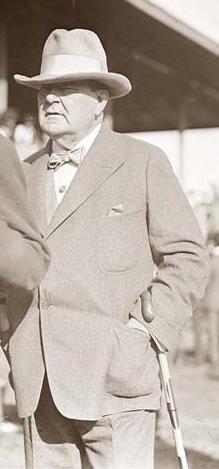Diamond Jim Brady
James Buchanan Brady (12 August 1856 – 13 April 1917), also known as Diamond Jim Brady, was an American businessman, financier, and philanthropist of the Gilded Age.
Biography
Born in New York City to a modest household, Brady worked his way up from bellboy and messenger. After gaining employment in the New York Central Railroad system, he became the chief assistant to the general manager by the age of 21. At 23, Brady parlayed his knowledge of the railroad industry and its officials to become a highly successful salesman for Manning, Maxwell and Moore, a railroad supply company.[1]
Known for his penchant for jewels, especially diamonds, he collected precious stones and jewelry in excess of US$ 2 million (adjusted for 2005 dollars, approx. $50 million).
Brady's enormous appetite and resultant girth were as legendary as his wealth. It was not unusual for Brady to eat enough food for ten people at a sitting. George Rector, owner of a favorite restaurant, described Brady as "the best 25 customers I ever had."[2] A typical Brady breakfast would be: eggs, pancakes, pork chops, cornbread, fried potatoes, hominy, muffins, and a beefsteak. For refreshment, a gallon of orange juice—or "golden nectar", as he called his favorite drink. Lunch might be two lobsters, deviled crabs, clams, oysters and beef, with a few pies for dessert. The usual evening meal began with an appetizer of two or three dozen oysters, six crabs, and a few servings of green turtle soup, followed by a main course of two whole ducks, six or seven lobsters, a sirloin steak, two servings of terrapin and a host of vegetables. For dessert, the gourmand enjoyed pastries and a two pound box of candy.
"Diamond Jim" is also known for his romantic association with singer Lillian Russell, a famously voluptuous beauty of the era. It is said that her eating habits were a perfect match for his own.
A gregarious man, Brady was a mainstay of Broadway nightlife. He often dined with popular society. After further investments in the stock market, Brady accumulated wealth estimated at $12 million. He was also known for being the first person in New York City to own an automobile (in 1895).
Brady donated a significant sum in 1912 to Johns Hopkins Hospital in Baltimore, Maryland, where he had once been treated.[3] The hospital created the James Buchanan Brady Urological Institute in his honor.
Death
He died in his sleep on April 13, 1917 of a stroke.[3]
Brady had never married, and after his death his estate was distributed to many institutions, most notably New York Hospital. When his body was examined, doctors discovered that his stomach was six times larger than that of an average person.
Legacy
He was the inspiration for a 1935 film written by Preston Sturges entitled Diamond Jim.
References
- ↑ M. M. & M., Time magazine, January 24, 1938. Retrieved on 2008-12-19. “The Brady fable got its pith from Charles A. Moore, founder of Manning, Maxwell & Moore, who took Brady on as a cub salesman in 1879 when the company was only a jobber for railroad supplies, sent Diamond Jim out on the road with instructions to spend all the money necessary to make customers like him. Diamond Jim stuck to this tenet through the panic of the middle nineties with such success that spending money to make money has been the Manning, Maxwell & Moore system to lick depressions ever since.”
- ↑ Diamond Jim Brady
- ↑ 3.0 3.1 Diamond Jim Brady Dies While Asleep. Bulk of Fortune of from $10,000,000 to $20,000,000 May Go to Johns Hopkins Hospital. Jewels for Metropolitan Museum. A Keen Man of Business. $200,000 for Johns Hopkins., New York Times, April 14, 1917. Retrieved on 2008-12-19. “James Buchanan Brady of New York died this morning from a heart attack at the age of 61. He literally slept into death, for his constant attendant had no warning of the fatal stroke.”
Further reading
- History's True Glutton or a Tall Tale? New York Times 12/30/08 [1]
